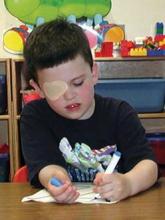Amblyopia treatment can lead to improved visual acuity in children from ages 3 to less than 13 years, but the average treatment response is smaller in children aged 7 and older, according to a meta-analysis of individual subject data from four randomized amblyopia treatment trials published online July 11 in Archives of Ophthalmology.
Studies have shown that amblyopia treatment is effective in some older children, but one question remains: Is there a relationship between the child’s age and the magnitude of treatment response.
To find out, Jonathan M. Holmes of the department of ophthalmology at the Mayo Clinic, Rochester, Minn., and his colleagues conducted a meta-analysis of four previous randomized multicenter clinical trials for the treatment of amblyopia conducted by the Pediatric Eye Disease Investigator Group, or PEDIG (Arch. Ophthalmol. 2011 July [doi:10.1001/archophthalmol.2011.179]). They used data from 996 children, each involved in one of four possible protocols:
• Protocol 1: Patching for 2 hours daily with near or distance activities (aged 3 to less than 7 years).
• Protocol 2: Treatment with atropine with or without a plano lens (aged 3 to less than 7 years).
• Protocol 3: Treatment with atropine or patching 2 hours daily (aged 7 to less than 13 years).
• Protocol 4: Use of Bangerter filter or patching 2 hours per day (aged 3 to less than 10 years).
Treatment response significantly decreased as children got older, especially among children whose amblyopia was more severe, the analysis showed. After researchers adjusted for covariates, children aged 3 to less than 5 with severe amblyopia showed a mean 4.16 lines of improved visual acuity. Children with severe amblyopia showed a mean 3.60 lines of improved visual acuity from ages 5 to less than 7 and 1.99 lines from ages 7 to less than 13.
Although the treatment response is significantly lower in older children versus younger children, the researchers pointed out that there was still an improvement – dramatic in some cases – in mean visual acuity among all age groups.
The analysis also found almost no difference in treatment response between children aged 3 to less than 5 years and children aged 5 to less than 7 years who had moderate amblyopia. The adjusted mean visual acuity was 2.29 lines for those aged 3 to less than 5 years, and 2.41 among those aged 5 to less than 7 years. For those children aged 7 to less than 13 years with moderate amblyopia, the adjusted mean improvement in visual acuity was 1.65 lines – a statistically significant difference.
"There are at least two possible reasons for reduced response to amblyopia treatment in older children," Mr. Holmes and his associates said. "It is widely believed that there is declining plasticity of the central nervous system as children age, although recent data on the treatment of amblyopia suggest that the plasticity of the nervous system remains throughout adolescence. Second, there may be poorer compliance when treating older children."
The strength of the study is that the meta-analysis used four randomized trials of individual subject data with similar entry criteria, length of follow-up, and use of a masked and standardized outcome assessment, the researchers said.
However, they added, the current study has several limitations. "Our ability to separate protocol effects from age effects is dependent on a single protocol (e.g., protocol 4), which was the only protocol that had overlap in age with all other protocols," the researchers said. "Also, protocol 4 did not include any children with severe amblyopia. Thus, separating an age effect from a protocol effect in severe amblyopia required that we assume the same protocol effects that were seen in moderate amblyopia ... (assuming that the lesser improvement seen in children 7 to less than 13 years of age was due to age and not to protocol)."
Additional limitations, the researchers said, include using arbitrary age categories to model age effects and using different visual acuity testing materials for children who were younger than age 7 years than for those aged 7 or older.
The researchers said they had no relevant financial disclosures. This study was supported by grants from the National Institutes of Health and Research to Prevent Blindness.


